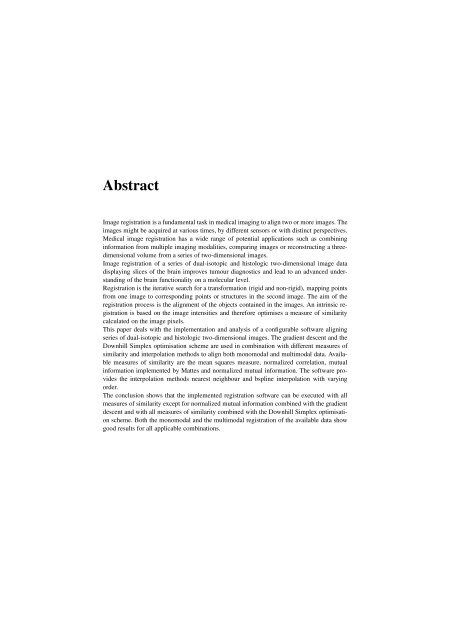View - JUWEL - Forschungszentrum Jülich
View - JUWEL - Forschungszentrum Jülich
View - JUWEL - Forschungszentrum Jülich
Sie wollen auch ein ePaper? Erhöhen Sie die Reichweite Ihrer Titel.
YUMPU macht aus Druck-PDFs automatisch weboptimierte ePaper, die Google liebt.
Abstract<br />
Image registration is a fundamental task in medical imaging to align two or more images. The<br />
images might be acquired at various times, by different sensors or with distinct perspectives.<br />
Medical image registration has a wide range of potential applications such as combining<br />
information from multiple imaging modalities, comparing images or reconstructing a threedimensional<br />
volume from a series of two-dimensional images.<br />
Image registration of a series of dual-isotopic and histologic two-dimensional image data<br />
displaying slices of the brain improves tumour diagnostics and lead to an advanced understanding<br />
of the brain functionality on a molecular level.<br />
Registration is the iterative search for a transformation (rigid and non-rigid), mapping points<br />
from one image to corresponding points or structures in the second image. The aim of the<br />
registration process is the alignment of the objects contained in the images. An intrinsic registration<br />
is based on the image intensities and therefore optimises a measure of similarity<br />
calculated on the image pixels.<br />
This paper deals with the implementation and analysis of a configurable software aligning<br />
series of dual-isotopic and histologic two-dimensional images. The gradient descent and the<br />
Downhill Simplex optimisation scheme are used in combination with different measures of<br />
similarity and interpolation methods to align both monomodal and multimodal data. Available<br />
measures of similarity are the mean squares measure, normalized correlation, mutual<br />
information implemented by Mattes and normalized mutual information. The software provides<br />
the interpolation methods nearest neighbour and bspline interpolation with varying<br />
order.<br />
The conclusion shows that the implemented registration software can be executed with all<br />
measures of similarity except for normalized mutual information combined with the gradient<br />
descent and with all measures of similarity combined with the Downhill Simplex optimisation<br />
scheme. Both the monomodal and the multimodal registration of the available data show<br />
good results for all applicable combinations.

















